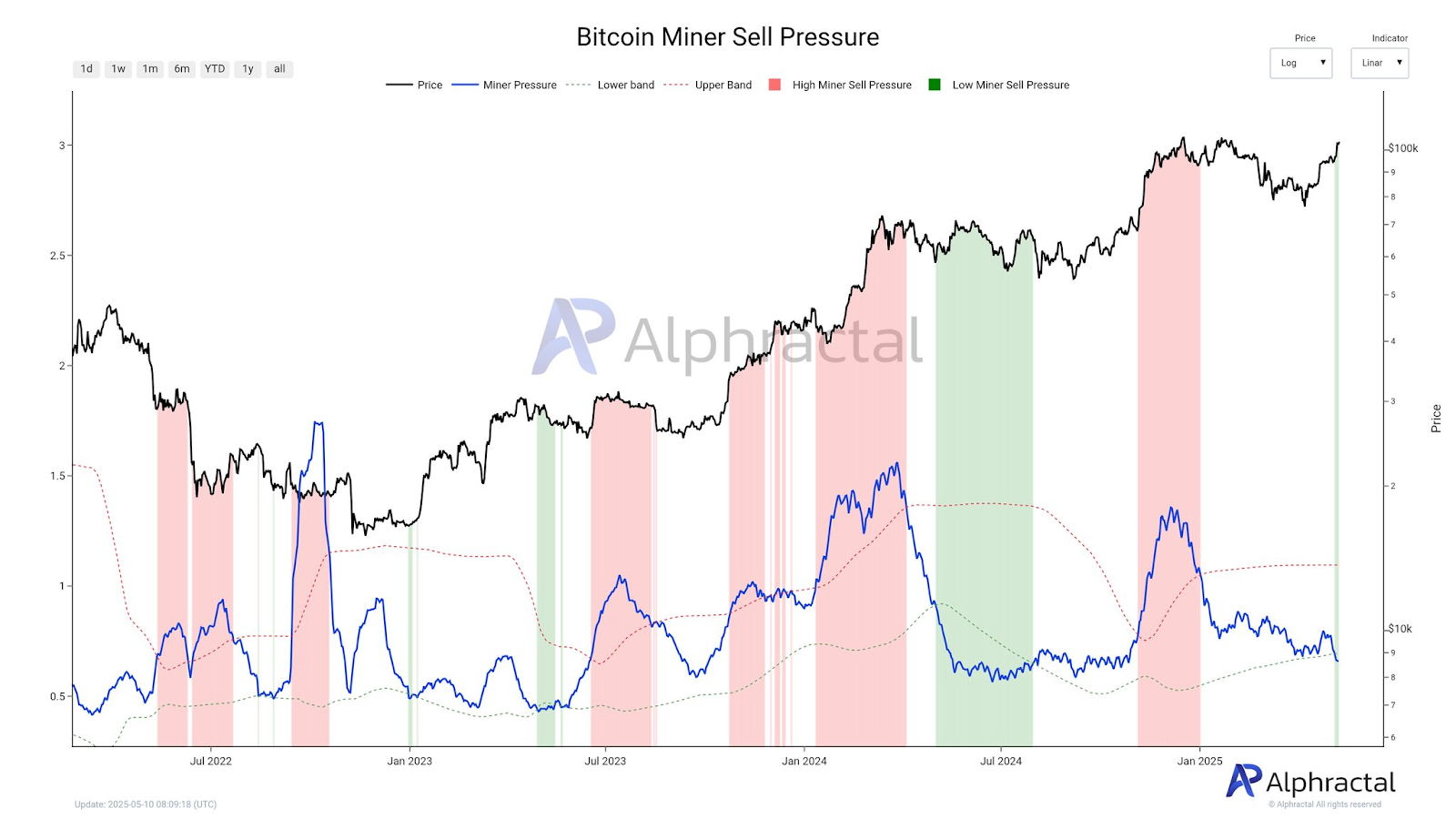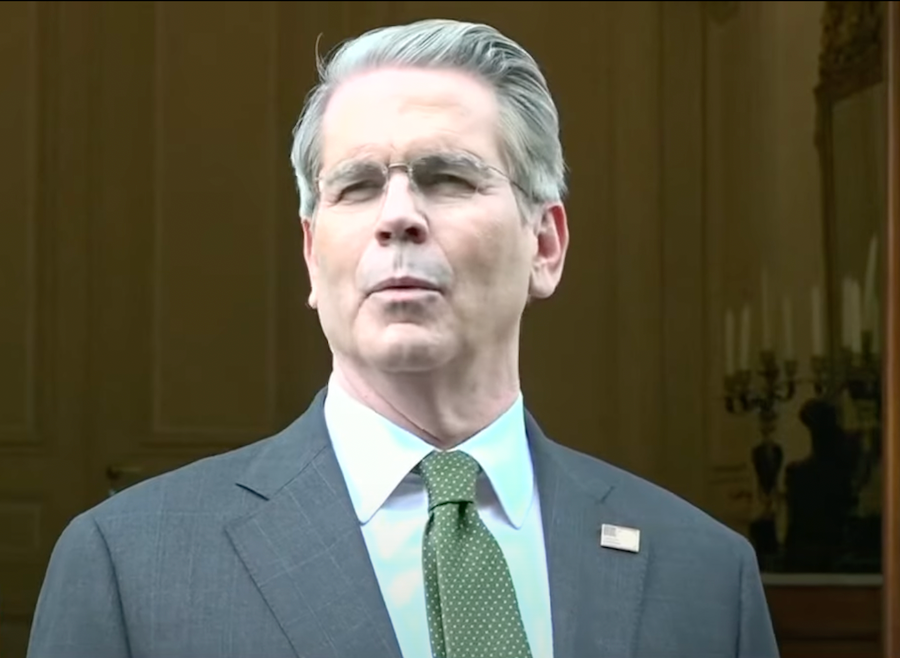Part 1: Bitcoin miners’ selling pressure drops to the lowest level since 2024 — is the market accumulating strength to set new highs?
1. Miners’ behavior changes: from selling to holding

According to the latest data from the cryptocurrency analysis platform Alphractal, the Bitcoin miner selling pressure indicator (which measures the ratio of miners' outflows to reserves within 30 days) has fallen below the lower track and reached its lowest level since 2024. This phenomenon shows that miners are shifting from the past mode of "selling to cover operating costs" to strategic hoarding.
This is in stark contrast to the plight of miners’ income being cut in half after the halving in 2024 (when miners’ daily selling volume increased from 900 to 1,200), but changes in the current market environment have prompted miners to adjust their strategies:
- Profit expectations drive hoarding: As the price of Bitcoin recently broke through $100,000 and approached its historical high, miners are more inclined to hold Bitcoin in anticipation of higher returns rather than cashing out in the short term.
- Industry structural optimization: The large-scale development of mining led by listed companies (such as Bitfarms and CleanSpark) has reduced the exit risk of inefficient miners, and the increase in industry concentration has eased the selling pressure.
- Historical experience: In past cycles, miners' excessive leverage and long-term holding have led to liquidity crises (such as the 2018 bear market), and now they are more focused on short-term financial stability.
2. Market resilience revealed by on-chain data
Alphractal’s miner selling pressure indicator shows that the current market structure is very different from the “panic selling” in early 2024:
- Long-term holders dominate: Currently, more than 80% of Bitcoin is held for more than 6 months, which is far lower than the short-term holder-dominated ratio of 1 at the top of the historical cycle, providing stable support for prices.
- Exchange reserves hit a new low: Bitcoin exchange reserves continue to decline, indicating that the market is in a "high-speed accumulation period" and selling pressure is dispersed by over-the-counter transactions or institutional holdings.
- Derivatives market risks: Although the spot market is stable, there are a large number of highly leveraged long positions in the $100,000 to $110,000 range, and price fluctuations may trigger a multi-billion dollar liquidation wave.
3. Price trends and future expectations
As of May 12, 2025, the price of Bitcoin is $104,250, up 1% in 24 hours and up more than 30% in the past month. The focus of market disagreement on the subsequent trend is:
- Technical signals: RSI (75) shows overbought, but MACD continues to rise; if the key support level of $10,000 is breached, it may trigger selling by short-term holders.
- Influence of macro variables: The Fed’s expectation of a rate cut (if the rate cut exceeds 100 basis points in 2025) may provide Bitcoin with a “Davis double-click” opportunity, but the risk of stagflation may weaken its safe-haven properties.
- Miner behavior dynamics: If the price breaks through $110,000, miner selling pressure may pick up, but the current low selling level indicates that the market may enter a "calm rise period."
Part 2: Market concerns behind the “substantial progress” in the China-US trade agreement
1. White House statement and outline of agreement

On May 11, U.S. Treasury Secretary Scott Bessant and Trade Representative Jamison Greer jointly announced that the U.S.-China trade negotiations had made "substantial progress" and the two sides had reached principled consensus on the following areas:
- Market Access: China pledged to expand imports of U.S. agricultural products and extend tariff exemptions for some U.S. technology products.
- Intellectual property protection: Establish a cross-border law enforcement cooperation mechanism to reduce barriers to technology transfer.
- Dispute Settlement Mechanism: Establish a permanent consultation platform to prevent the escalation of trade frictions.
2. Market reaction and concerns
Despite positive official signals, the lack of details on the agreement has led investors to be cautiously optimistic:
- Uncertainty remains: The Trump administration's policy repetition (such as the "one-day tour" of electronic tariff exemption in 2024) has weakened market confidence, and risky assets remain under pressure before the agreement is implemented.
- Structural contradictions remain unresolved: China and the United States’ competitive policies in areas such as semiconductors and artificial intelligence (such as “Trade War 2.0”) may continue through non-tariff means.
- Liquidity impact differentiation: If the agreement pushes the U.S. dollar index (DXY) down, Bitcoin may benefit from the restart of the "anti-fiat currency" narrative; but if the breakdown of negotiations triggers safe-haven demand, gold may divert funds.
3. The knock-on effect on the global economy
The possible systemic impacts of Sino-US trade easing include:
- Supply chain reshaping: The agreement may accelerate the "nearshore outsourcing" trend, Mexico and Southeast Asia will enhance their status as manufacturing hubs, and the demand for cross-border cryptocurrency payments will grow.
- Expectations of inflation easing: Tariff cuts are expected to reduce pressure on the US CPI, provide room for the Federal Reserve to cut interest rates, and indirectly benefit risky assets.
- Geopolitical risk transfer: If China-US cooperation strengthens, "alternative crises" such as the Russia-Ukraine conflict and the situation in the Middle East may become new sources of market volatility.
Part 3: Market game and investment strategy under the interweaving of two main lines
1. The resonance between Bitcoin and macroeconomic policies
- Interest rate sensitivity and correlation: The correlation between Bitcoin and the Nasdaq index (0.78) shows that it has not yet deviated from the traditional risk asset framework. If the China-US trade agreement boosts technology stocks, Bitcoin may benefit simultaneously.
- Miner behavior as a leading indicator: Historical data shows that after miner selling pressure hits bottom, Bitcoin tends to enter an upward cycle (such as the bull market after miner capitulation in 2023), and the current low selling level may indicate a similar trend.
2. Risk and opportunity assessment
- Short-term volatility risk: The accumulation of Bitcoin derivative leverage and the unclear details of the China-US agreement may trigger price fluctuations, and the support level of $10,000 will become the watershed between long and short positions.
- Long-term narrative strengthened: The average daily amount of Bitcoin ETF funds absorbed (800 coins) is still higher than the output of miners (450 coins), and the institutionalization process offsets some market shocks.
Conclusion: Deterministic Logic in Complex Markets
The global market in May 2025 is at the dual nodes of Bitcoin's "post-halving cycle" and China-US "trade relationship rebalancing". The low selling pressure of miners and the progress of the White House agreement seem independent, but in fact they both point to a core proposition: asset repricing under liquidity reconstruction. Whether Bitcoin breaks through the previous high or the China-US agreement is implemented, the market will eventually verify a truth - in the collision of the macro iron curtain and the crypto narrative, only assets with both flexibility and efficiency can win in the long run.














